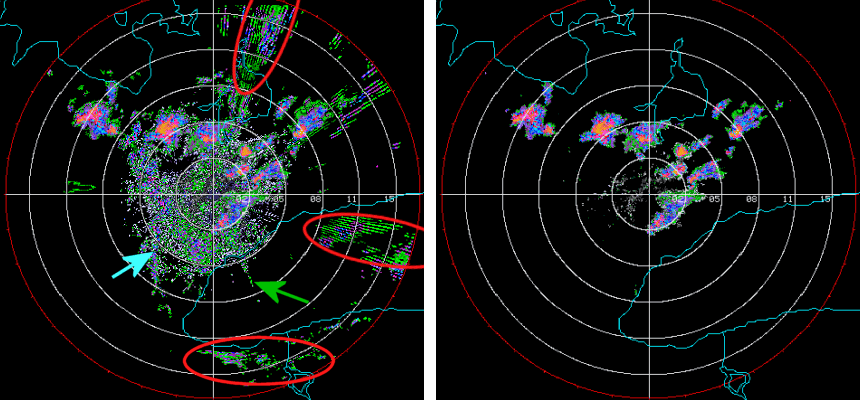Weather Radar Clutter

ambiguous
(folded) returns
(folded) returns
urban
echos
echos
ground
clutter
clutter
anomalous_____
propagation
propagation
a) unfiltered
b) filtered
Figure 1: Radar image with multiple clutter

ambiguous
(folded) returns
(folded) returns
urban
echos
echos
ground
clutter
clutter
anomalous_____
propagation
propagation
a) unfiltered
b) filtered
Figure 1: Radar image with multiple clutter

ambiguous
(folded) returns
(folded) returns
urban echos
ground
clutter
clutter
anomalous
propagation
propagation
a) unfiltered
b) filtered
Figure 1: Radar image with multiple clutter
Weather Radar Clutter
There is a wide range of other reasons (some can be quite strange) why returns and echoes can be received at the weather radar antenna. Some examples are presented here:
- Insects & Bugs (perhaps clouds of them).
Clearly, insects and bugs will provide some level of reflections (especially at lower elevations near the land). These can be useful as 'tracers' which could for example track low-level winds such as sea breezes . Insect returns are most common closer to the weather radar station. - Dry roll convection in the boundary layer
(this is a phenomenon which is mostly only detectable by clutter from insects and birds).
When conditions are just right, there can be 'dry thermal plumes' of rising warm, moist air in the lowest few hundred meters of the atmosphere. These will often form into long, 'rolls'. They are very difficult to detect (unless potentially using reflections from bugs and birds, etc.). This can therefore be defined as a phenomenon. - Sea Clutter.
Under certain wind and other atmospheric conditions, sharp-tipped waves can reflect microwave energy back to the radar; this phenomenon is known as sea clutter. Sea clutter can be of modest to large reflectivity and extend to long-ranges. It can complicate 'near-surface' velocity analysis by returning a mix of both the wind and wave motion. It is common that sea clutter is caused by atmospheric refraction and the climatic conditions near the coast are particularly susceptible to this. - Ships.
Sea Clutter patterns can be disrupted by passing ships. - Bird migration.
Strange but logical. The returns from flocks of migrating birds will show up at weather radar systems (this phenomenon is often referred to as Angel Echo). Bird reflections can be quite troublesome in radar meteorology. It only takes one bird per volume to return a large, moving radar echo. During the migration season, the effect can be quite serious. However, using Doppler techniques, the radial velocity of migrating flocks of birds will normally fall into a specific category. - Anomalous propagation.
Under certain atmospheric conditions, the refractive index of air can change with height in such a way as to bend the transmitted beam back down towards the surface; it then hits the ground, and returns along its curved path to the radar. This is commonly known as anomalous propagation. - Chaff.
Military system to disperse many small reflective particles into the atmosphere. These disperse and slowly fall to the ground. They are high reflective and are essentially used to 'jam' the radar display. - Aircraft.
For a weather radar, reflections from aircraft passing through the airspace will be considered as clutter. - Radome Clutter.
The effects of a radome can increase the general clutter, noise and interference received at the antenna. - etc.
